本文分享以下7种 AI 智能体的架构设计模式和代码级落地实现。
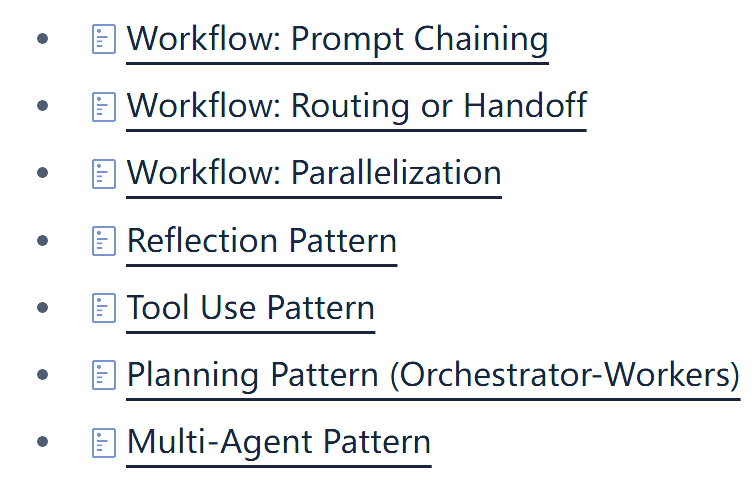
一、AI 智能体的架构设计模式和落地实现
架构设计模式一、Workflow: Prompt Chaining
一个大语言模型(LLM)调用的输出会依次成为下一个 LLM 调用的输入。这种模式将一个任务分解成一系列固定的步骤,每一步都由一个 LLM 调用来处理,它会处理前一个 LLM 调用的输出。这种模式适用于那些可以被清晰地分解成可预测的、按顺序排列的子任务的任务。

1、使用场景
-
生成结构化文档:LLM1 创建大纲,LLM2根据标准验证大纲,LLM3根据经过验证的大纲撰写内容。
-
多步骤数据处理:提取信息,转换信息,然后对信息进行总结。
-
基于精选输入生成新闻通讯。
2、落地实现代码
import osfrom google import genai
# Configure the client (ensure GEMINI_API_KEY is set in your environment)client = genai.Client(api_key=os.environ["GEMINI_API_KEY"])
# --- Step 1: Summarize Text ---original_text = "Large language models are powerful AI systems trained on vast amounts of text data. They can generate human-like text, translate languages, write different kinds of creative content, and answer your questions in an informative way."prompt1 = f"Summarize the following text in one sentence: {original_text}"
# Use client.models.generate_contentresponse1 = client.models.generate_content( model='gemini-2.0-flash', contents=prompt1)summary = response1.text.strip()print(f"Summary: {summary}")
# --- Step 2: Translate the Summary ---prompt2 = f"Translate the following summary into French, only return the translation, no other text: {summary}"
# Use client.models.generate_contentresponse2 = client.models.generate_content( model='gemini-2.0-flash', contents=prompt2)translation = response2.text.strip()print(f"Translation: {translation}")
架构设计模式二、 Workflow: Routing
一开始的时候,有一个大语言模型(LLM)就像一个交通指挥员。它会看看用户说的是啥,然后把用户的话送到最适合处理这个任务的地方,可能是另一个专门的 LLM,也可能是别的任务。这种做法就像是把不同的工作分给不同的人去做,这样就可以针对每个具体的工作,用专门的提示词、不同的模型或者特定的工具来优化。而且,对于简单的任务,可以用小一点的模型来处理,这样能提高效率,还能省点钱。一旦任务被分配出去,被选中的那个“小助手”就会负责把任务完成。
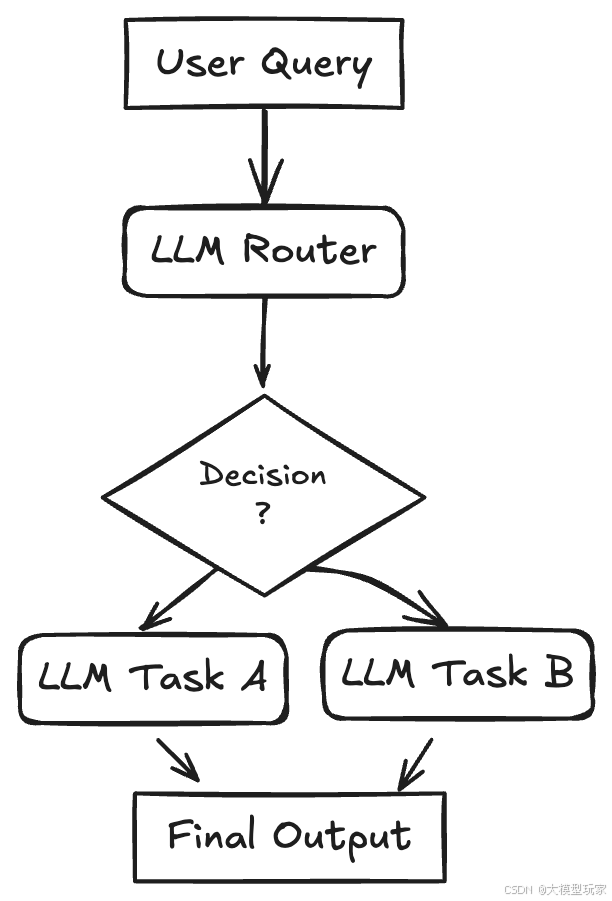
1、使用场景
- 客户支持系统:把客户的问题分给专门处理账单、技术支持或者产品信息的客服人员。
- 分层使用 LLM:把简单的问题交给速度快、成本低的模型(比如:Llama 3.1 8B),把复杂或者不常见的问题交给能力更强的模型(比如:Gemini 1.5 Pro)。
- 内容生成:把写博客文章、社交媒体更新或者广告文案的请求,分给不同的专门的提示词或者模型。
2、落地实现代码
import osimport jsonfrom google import genaifrom pydantic import BaseModelimport enum
# Configure the client (ensure GEMINI_API_KEY is set in your environment)client = genai.Client(api_key=os.environ["GEMINI_API_KEY"])
# Define Routing Schemaclass Category(enum.Enum): WEATHER = "weather" SCIENCE = "science" UNKNOWN = "unknown"
class RoutingDecision(BaseModel): category: Category reasoning: str
# Step 1: Route the Queryuser_query = "What's the weather like in Paris?"# user_query = "Explain quantum physics simply."# user_query = "What is the capital of France?"
prompt_router = f"""Analyze the user query below and determine its category.Categories:- weather: For questions about weather conditions.- science: For questions about science.- unknown: If the category is unclear.
Query: {user_query}"""
# Use client.models.generate_content with config for structured outputresponse_router = client.models.generate_content( model= 'gemini-2.0-flash-lite', contents=prompt_router, config={ 'response_mime_type': 'application/json', 'response_schema': RoutingDecision, },)print(f"Routing Decision: Category={response_router.parsed.category}, Reasoning={response_router.parsed.reasoning}")
# Step 2: Handoff based on Routingfinal_response = ""if response_router.parsed.category == Category.WEATHER: weather_prompt = f"Provide a brief weather forecast for the location mentioned in: '{user_query}'" weather_response = client.models.generate_content( model='gemini-2.0-flash', contents=weather_prompt ) final_response = weather_response.textelif response_router.parsed.category == Category.SCIENCE: science_response = client.models.generate_content( model="gemini-2.5-flash-preview-04-17", contents=user_query ) final_response = science_response.textelse: unknown_response = client.models.generate_content( model="gemini-2.0-flash-lite", contents=f"The user query is: {prompt_router}, but could not be answered. Here is the reasoning: {response_router.parsed.reasoning}. Write a helpful response to the user for him to try again." ) final_response = unknown_response.textprint(f"\nFinal Response: {final_response}")
架构设计模式三、 Workflow: Parallelization
一个任务被拆成了好几个互不干扰的小任务,这些小任务同时由多个大语言模型(LLM)来处理,最后把它们的结果汇总起来。这种模式就是让任务同时进行。一开始的问题(或者问题的一部分)会同时发给多个 LLM,每个都有自己的提示词或者目标。等所有这些小任务都完成了,就把它们各自的结果收集起来,交给一个最后的汇总 LLM,这个 LLM 把它们合成最终的回答。如果小任务之间没有相互依赖,这样可以减少等待时间,或者通过像多数投票或者生成多种选择这样的方法来提高质量。
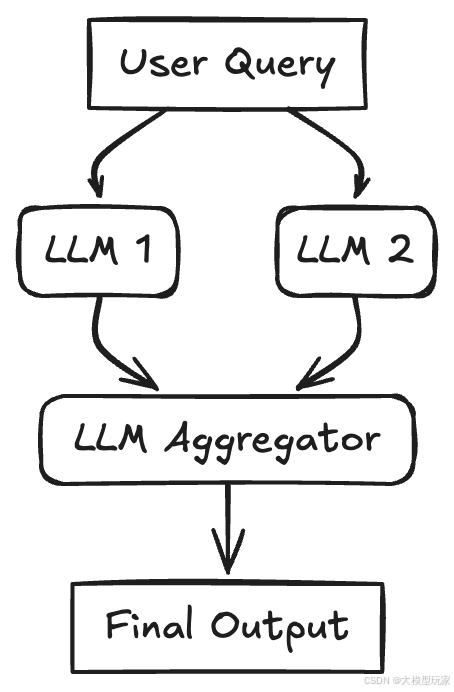
1、使用场景
-
带查询分解的 RAG:把一个复杂的查询分成几个小查询,同时运行每个小查询的检索,然后合成结果。
-
分析大文档:把文档分成几部分,同时总结每部分,然后再把总结合并起来。
-
生成多种视角:用不同的角色提示词问多个 LLM 同一个问题,然后汇总它们的回答。
-
对数据进行类似 MapReduce 的操作。
2、落地实现代码
import osimport asyncioimport timefrom google import genai
# Configure the client (ensure GEMINI_API_KEY is set in your environment)client = genai.Client(api_key=os.environ["GEMINI_API_KEY"])
async def generate_content(prompt: str) -> str: response = await client.aio.models.generate_content( model="gemini-2.0-flash", contents=prompt ) return response.text.strip()
async def parallel_tasks(): # Define Parallel Tasks topic = "a friendly robot exploring a jungle" prompts = [ f"Write a short, adventurous story idea about {topic}.", f"Write a short, funny story idea about {topic}.", f"Write a short, mysterious story idea about {topic}." ] # Run tasks concurrently and gather results start_time = time.time() tasks = [generate_content(prompt) for prompt in prompts] results = await asyncio.gather(*tasks) end_time = time.time() print(f"Time taken: {end_time - start_time} seconds")
print("\n--- Individual Results ---") for i, result in enumerate(results): print(f"Result {i+1}: {result}\n")
# Aggregate results and generate final story story_ideas = '\n'.join([f"Idea {i+1}: {result}" for i, result in enumerate(results)]) aggregation_prompt = f"Combine the following three story ideas into a single, cohesive summary paragraph:{story_ideas}" aggregation_response = await client.aio.models.generate_content( model="gemini-2.5-flash-preview-04-17", contents=aggregation_prompt ) return aggregation_response.text
result = await parallel_tasks()print(f"\n--- Aggregated Summary ---\n{result}")

架构设计模式 四、Reflection Pattern
想象一下,有一个“小助手”(Agent)在做任务,做完之后,它会自己检查自己的工作,看看哪里做得不好,然后根据这些反馈,一遍又一遍地改进自己的回答。这种模式也被称为“评估者-优化器”,它就像是一个自我纠错的循环。
一开始,一个大语言模型(LLM)生成一个回答或者完成一个任务。然后,第二个 LLM(或者同一个 LLM,但用不同的提示词)就像一个“质检员”,来检查最初的结果,看看它是否符合要求或者达到了期望的质量。这个“质检员”的反馈会再送回去,让 LLM 根据这个反馈来改进输出。这个循环可以一直重复,直到“质检员”确认结果符合要求,或者得到了一个让人满意的结果。

1、使用场景
- 代码生成:先写出代码,运行它,然后用错误信息或者测试结果作为反馈来修复漏洞。
- 写作和润色:先生成一个初稿,思考它的清晰度和语气,然后再进行修改。
- 复杂问题解决:先制定一个计划,评估它的可行性,然后根据评估结果进行改进。
- 信息检索:先搜索信息,然后用一个评估 LLM 来检查是否找到了所有需要的细节,然后再给出答案。
2、落地实现代码
import osimport jsonfrom google import genaifrom pydantic import BaseModelimport enum
# Configure the client (ensure GEMINI_API_KEY is set in your environment)client = genai.Client(api_key=os.environ["GEMINI_API_KEY"])
class EvaluationStatus(enum.Enum): PASS = "PASS" FAIL = "FAIL"
class Evaluation(BaseModel): evaluation: EvaluationStatus feedback: str reasoning: str
# --- Initial Generation Function ---def generate_poem(topic: str, feedback: str = None) -> str: prompt = f"Write a short, four-line poem about {topic}." if feedback: prompt += f"\nIncorporate this feedback: {feedback}"
response = client.models.generate_content( model='gemini-2.0-flash', contents=prompt ) poem = response.text.strip() print(f"Generated Poem:\n{poem}") return poem
# --- Evaluation Function ---def evaluate(poem: str) -> Evaluation: print("\n--- Evaluating Poem ---") prompt_critique = f"""Critique the following poem. Does it rhyme well? Is it exactly four lines? Is it creative? Respond with PASS or FAIL and provide feedback.
Poem:{poem}""" response_critique = client.models.generate_content( model='gemini-2.0-flash', contents=prompt_critique, config={ 'response_mime_type': 'application/json', 'response_schema': Evaluation, }, ) critique = response_critique.parsed print(f"Evaluation Status: {critique.evaluation}") print(f"Evaluation Feedback: {critique.feedback}") return critique
# Reflection Loop max_iterations = 3current_iteration = 0topic = "a robot learning to paint"
# simulated poem which will not pass the evaluationcurrent_poem = "With circuits humming, cold and bright,\nA metal hand now holds a brush"
while current_iteration < max_iterations: current_iteration += 1 print(f"\n--- Iteration {current_iteration} ---") evaluation_result = evaluate(current_poem)
if evaluation_result.evaluation == EvaluationStatus.PASS: print("\nFinal Poem:") print(current_poem) break else: current_poem = generate_poem(topic, feedback=evaluation_result.feedback) if current_iteration == max_iterations: print("\nMax iterations reached. Last attempt:") print(current_poem)
架构设计模式五、Tool Use Pattern
大语言模型(LLM)可以调用外部的函数或者 API,这样就能和外面的世界互动,获取信息或者执行操作。这种模式通常被称为“函数调用”,也是大家最熟悉的一种模式。LLM 会得到一些可用工具(比如:函数、API、数据库等)的定义,这些定义包括工具的名字、描述和输入的格式。根据用户的问题,LLM 可以决定调用一个或多个工具,它会生成一个符合所需格式的结构化输出(比如:JSON 格式)。这个输出被用来执行实际的外部工具或函数,然后把结果返回给 LLM。LLM 再用这个结果来形成对用户的最终回答。这就大大扩展了 LLM 的能力,让它能做的事情远远超出了它训练时的数据。
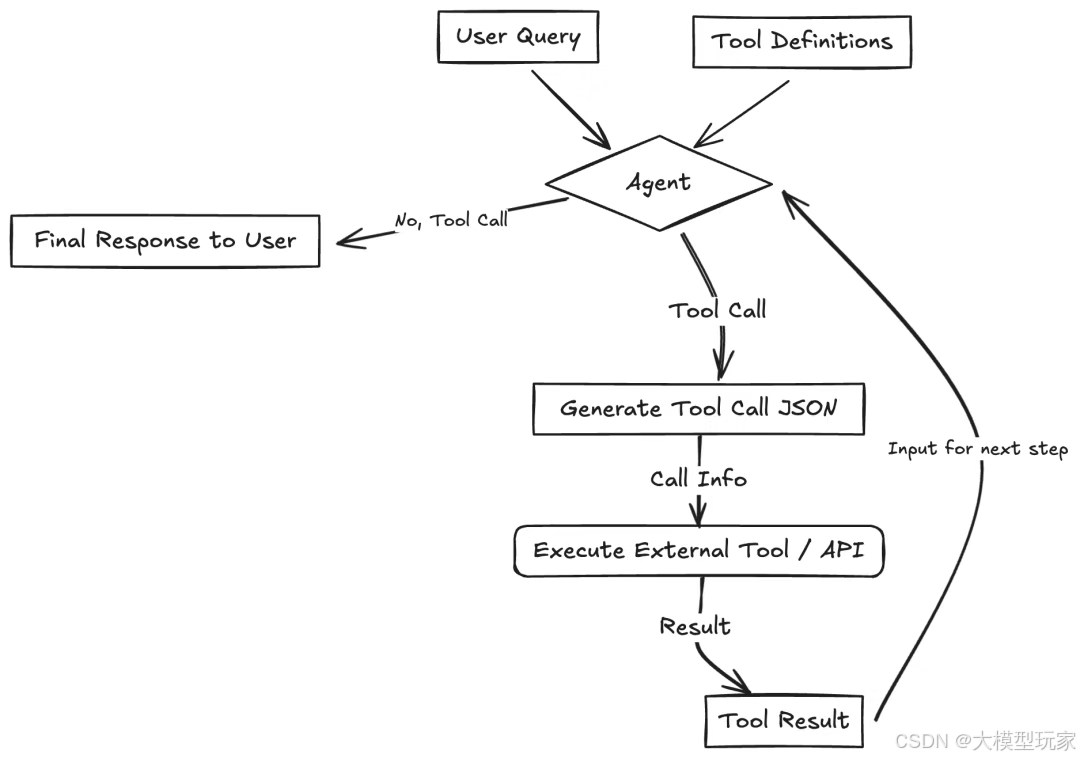
1、使用场景
- 用日历 API 来预约会议。
- 通过金融 API 获取实时股票价格。
- 在向量数据库中搜索相关文档(比如:RAG)。
- 控制智能家居设备。
- 执行代码片段。
2、落地实现代码
import osfrom google import genaifrom google.genai import types
# Configure the client (ensure GEMINI_API_KEY is set in your environment)client = genai.Client(api_key=os.environ["GEMINI_API_KEY"])
# Define the function declaration for the modelweather_function = { "name": "get_current_temperature", "description": "Gets the current temperature for a given location.", "parameters": { "type": "object", "properties": { "location": { "type": "string", "description": "The city name, e.g. San Francisco", }, }, "required": ["location"], },}
# Placeholder function to simulate API calldef get_current_temperature(location: str) -> dict: return {"temperature": "15", "unit": "Celsius"}
# Create the config object as shown in the user's example# Use client.models.generate_content with model, contents, and configtools = types.Tool(function_declarations=[weather_function])contents = ["What's the temperature in London right now?"]response = client.models.generate_content( model='gemini-2.0-flash', contents=contents, config = types.GenerateContentConfig(tools=[tools]))
# Process the Response (Check for Function Call)response_part = response.candidates[0].content.parts[0]if response_part.function_call: function_call = response_part.function_call print(f"Function to call: {function_call.name}") print(f"Arguments: {dict(function_call.args)}")
# Execute the Function if function_call.name == "get_current_temperature": # Call the actual function api_result = get_current_temperature(*function_call.args) # Append function call and result of the function execution to contents follow_up_contents = [ types.Part(function_call=function_call), types.Part.from_function_response( name="get_current_temperature", response=api_result ) ] # Generate final response response_final = client.models.generate_content( model="gemini-2.0-flash", contents=contents + follow_up_contents, config=types.GenerateContentConfig(tools=[tools]) ) print(response_final.text) else: print(f"Error: Unknown function call requested: {function_call.name}")else: print("No function call found in the response.") print(response.text)
架构设计模式 六、Planning Pattern (Orchestrator-Workers)
想象一下,有一个“总指挥官”(中央规划者 LLM),它会把一个复杂的任务拆分成一系列的小任务,然后把这些小任务分派给专门的“工人”(工作 Agent,通常会用到工具调用)去执行。这种模式主要是通过创建一个初始的“计划”来解决需要多步推理的复杂问题。这个计划是根据用户的输入动态生成的。然后,这些小任务会被分配给“工人”去执行,如果条件允许,它们可以同时进行。还有一个“协调者”或者“合成者” LLM,它会收集工人们的结果,看看整体目标是否达成。如果达成了,它就把最终结果整合起来;如果没达成,它可能会重新规划。这种方式可以减轻任何一个 LLM 调用的认知负担,提高推理质量,减少错误,并且能让工作流程动态适应。这和“路由”的关键区别在于,规划者生成的是一个多步骤的计划,而不是选择一个单一的下一步。
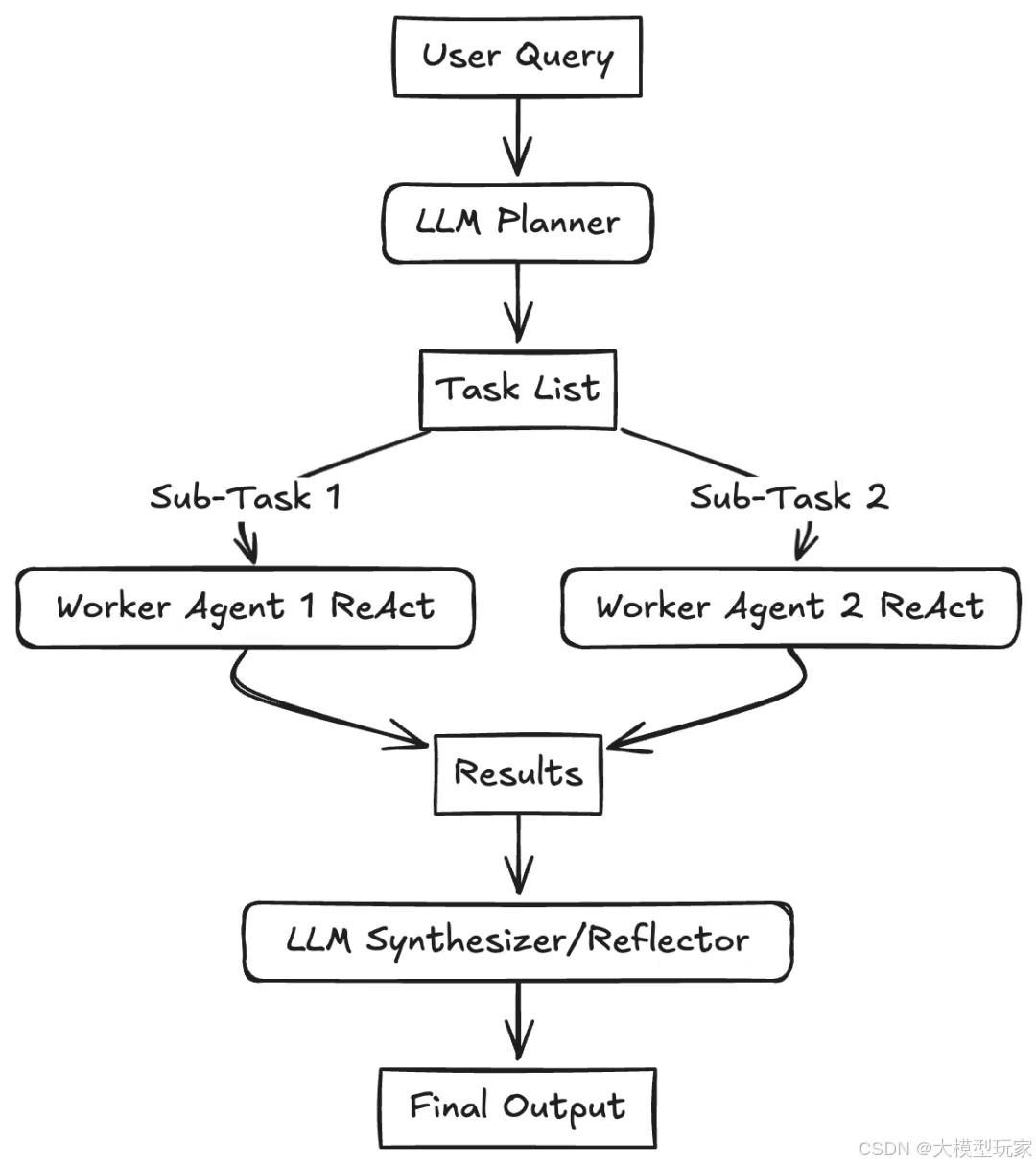
1、使用场景
- 复杂的软件开发任务:把“开发一个功能”拆分成规划、编码、测试和文档编写等子任务。
- 研究和报告生成:规划步骤,比如:文献搜索、数据提取、分析和报告撰写。
- 多模态任务:规划涉及图像生成、文本分析和数据整合的步骤。
- 执行复杂的用户请求,比如“计划一个为期3天的巴黎之旅,预订机票和预算内的酒店”。
2、落地实现代码
import osfrom google import genaifrom pydantic import BaseModel, Fieldfrom typing import List
# Configure the client (ensure GEMINI_API_KEY is set in your environment)client = genai.Client(api_key=os.environ["GEMINI_API_KEY"])
# Define the Plan Schemaclass Task(BaseModel): task_id: int description: str assigned_to: str = Field(description="Which worker type should handle this? E.g., Researcher, Writer, Coder")
class Plan(BaseModel): goal: str steps: List[Task]
# Step 1: Generate the Plan (Planner LLM)user_goal = "Write a short blog post about the benefits of AI agents."
prompt_planner = f"""Create a step-by-step plan to achieve the following goal. Assign each step to a hypothetical worker type (Researcher, Writer).
Goal: {user_goal}"""
print(f"Goal: {user_goal}")print("Generating plan...")
# Use a model capable of planning and structured outputresponse_plan = client.models.generate_content( model='gemini-2.5-pro-preview-03-25', contents=prompt_planner, config={ 'response_mime_type': 'application/json', 'response_schema': Plan, },)
# Step 2: Execute the Plan (Orchestrator/Workers - Omitted for brevity) for step in response_plan.parsed.steps: print(f"Step {step.task_id}: {step.description} (Assignee: {step.assigned_to})")
架构设计模式七、 Multi-Agent Pattern
多个不同的“小助手”(Agent),每个都有特定的角色、个性或者专长,一起合作来实现一个共同的目标。这种模式使用的是自动或者半自动的智能体。每个智能体可能都有一个独特的角色(比如:项目经理、程序员、测试员、批评者),专门的知识,或者能用到特定的工具。它们会相互交流和合作,通常是由一个中央的“协调者”或者“管理者”代理(就像图里的项目经理)来协调,或者用接力逻辑,一个智能体把控制权交给另一个智能体,两种实现方式如下:
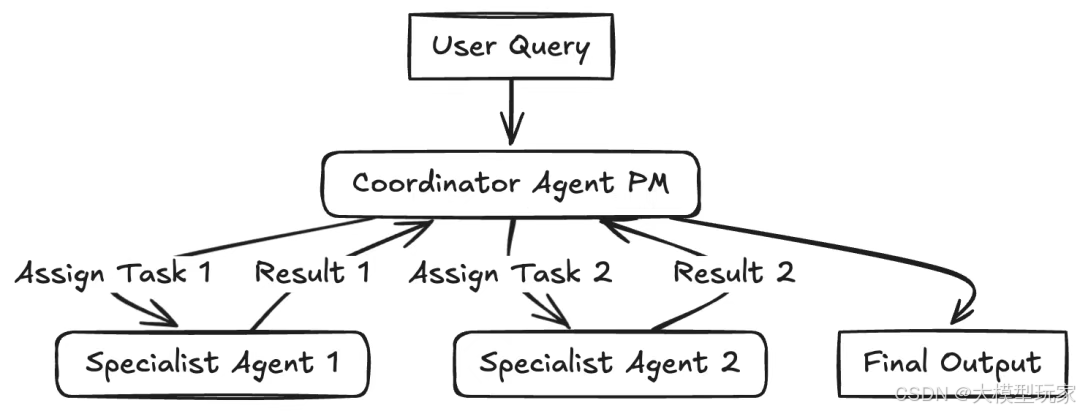
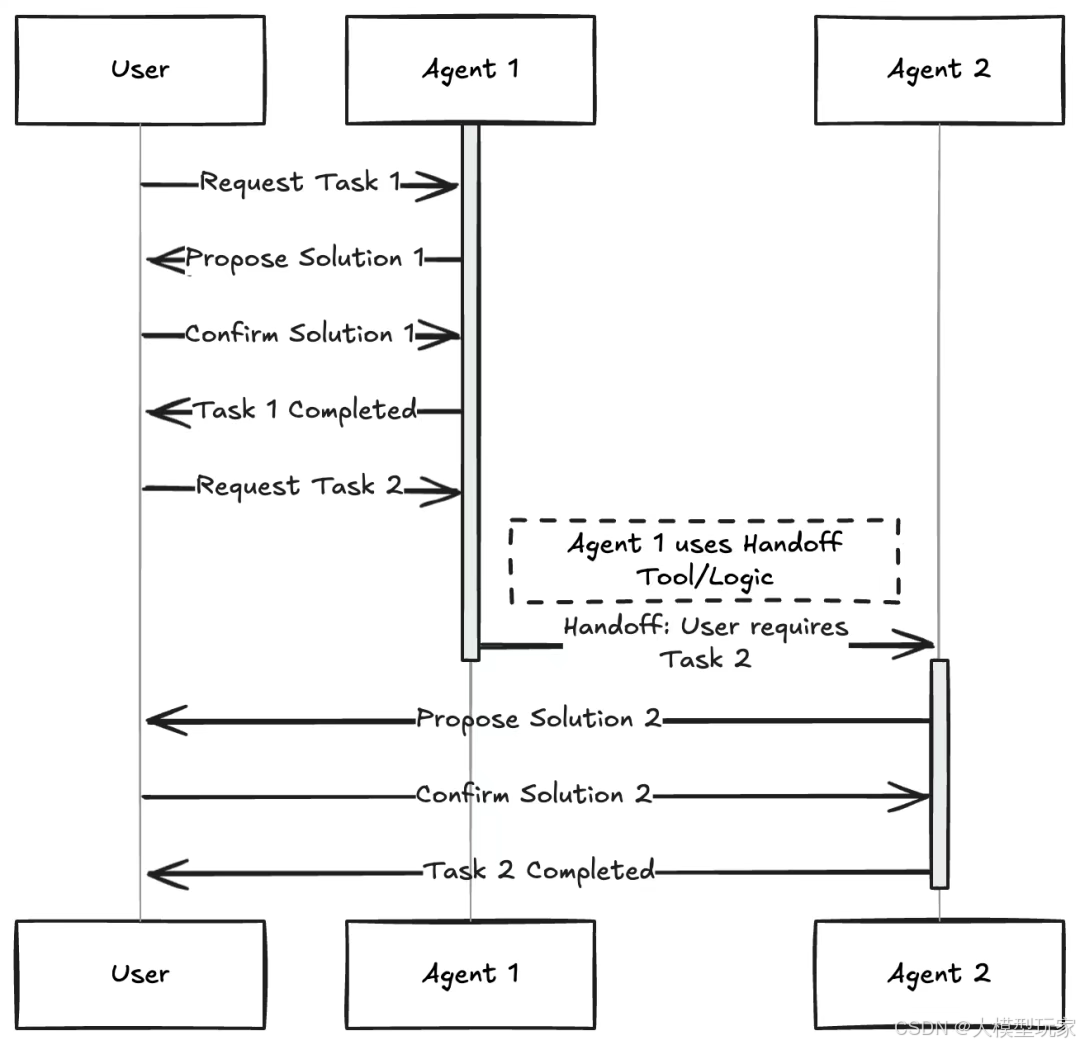
1、使用场景
- 用不同的 AI 角色模拟辩论或者头脑风暴会议。
- 复杂的软件创建,涉及规划、编程、测试和部署的智能体。
- 运行虚拟实验或者模拟,智能体代表不同的参与者。
- 协作写作或者内容创作过程。
2、落地实现代码
*注意*:下面的例子是一个简化的例子,展示如何使用多智能体模式,用接力逻辑和结构化输出。我建议可以看看 LangGraph Multi-Agent Swarm 或者Crew AI。
from google import genaifrom pydantic import BaseModel, Field
# Configure the client (ensure GEMINI_API_KEY is set in your environment)client = genai.Client(api_key=os.environ["GEMINI_API_KEY"])
# Define Structured Output Schemasclass Response(BaseModel): handoff: str = Field(default="", description="The name/role of the agent to hand off to. Available agents: 'Restaurant Agent', 'Hotel Agent'") message: str = Field(description="The response message to the user or context for the next agent")
# Agent Functiondef run_agent(agent_name: str, system_prompt: str, prompt: str) -> Response: response = client.models.generate_content( model='gemini-2.0-flash', contents=prompt, config = {'system_instruction': f'You are {agent_name}. {system_prompt}', 'response_mime_type': 'application/json', 'response_schema': Response} ) return response.parsed
# Define System Prompts for the agentshotel_system_prompt = "You are a Hotel Booking Agent. You ONLY handle hotel bookings. If the user asks about restaurants, flights, or anything else, respond with a short handoff message containing the original request and set the 'handoff' field to 'Restaurant Agent'. Otherwise, handle the hotel request and leave 'handoff' empty."restaurant_system_prompt = "You are a Restaurant Booking Agent. You handle restaurant recommendations and bookings based on the user's request provided in the prompt."
# Prompt to be about a restaurantinitial_prompt = "Can you book me a table at an Italian restaurant for 2 people tonight?"print(f"Initial User Request: {initial_prompt}")
# Run the first agent (Hotel Agent) to force handoff logicoutput = run_agent("Hotel Agent", hotel_system_prompt, initial_prompt)
# simulate a user interaction to change the prompt and handoffif output.handoff == "Restaurant Agent": print("Handoff Triggered: Hotel to Restaurant") output = run_agent("Restaurant Agent", restaurant_system_prompt, initial_prompt)elif output.handoff == "Hotel Agent": print("Handoff Triggered: Restaurant to Hotel") output = run_agent("Hotel Agent", hotel_system_prompt, initial_prompt)
print(output.message)
总之,这些模式可不是死板的规则,而是灵活的积木块。在现实世界里的智能体系统,常常会把多种模式的元素组合起来用。比如,一个做规划的智能体可能会用到工具调用,而它的“工人”们可能会用到自我评估。一个有多智能体的系统,可能会在内部用路由来分配任务。
对于任何大语言模型的应用,特别是复杂的智能体系统,成功的关键是要靠实际测试来看效果。得先定好衡量标准,然后去测量性能,找出哪里卡住了或者哪里出错了,接着再改进设计。别把事情搞得过于复杂。
普通人如何抓住AI大模型的风口?
领取方式在文末
为什么要学习大模型?
目前AI大模型的技术岗位与能力培养随着人工智能技术的迅速发展和应用 , 大模型作为其中的重要组成部分 , 正逐渐成为推动人工智能发展的重要引擎 。大模型以其强大的数据处理和模式识别能力, 广泛应用于自然语言处理 、计算机视觉 、 智能推荐等领域 ,为各行各业带来了革命性的改变和机遇 。
目前,开源人工智能大模型已应用于医疗、政务、法律、汽车、娱乐、金融、互联网、教育、制造业、企业服务等多个场景,其中,应用于金融、企业服务、制造业和法律领域的大模型在本次调研中占比超过 30%。

随着AI大模型技术的迅速发展,相关岗位的需求也日益增加。大模型产业链催生了一批高薪新职业:

人工智能大潮已来,不加入就可能被淘汰。如果你是技术人,尤其是互联网从业者,现在就开始学习AI大模型技术,真的是给你的人生一个重要建议!
最后
如果你真的想学习大模型,请不要去网上找那些零零碎碎的教程,真的很难学懂!你可以根据我这个学习路线和系统资料,制定一套学习计划,只要你肯花时间沉下心去学习,它们一定能帮到你!
大模型全套学习资料领取
这里我整理了一份AI大模型入门到进阶全套学习包,包含学习路线+实战案例+视频+书籍PDF+面试题+DeepSeek部署包和技巧,需要的小伙伴文在下方免费领取哦,真诚无偿分享!!!
vx扫描下方二维码即可
加上后会一个个给大家发

部分资料展示
一、 AI大模型学习路线图
整个学习分为7个阶段
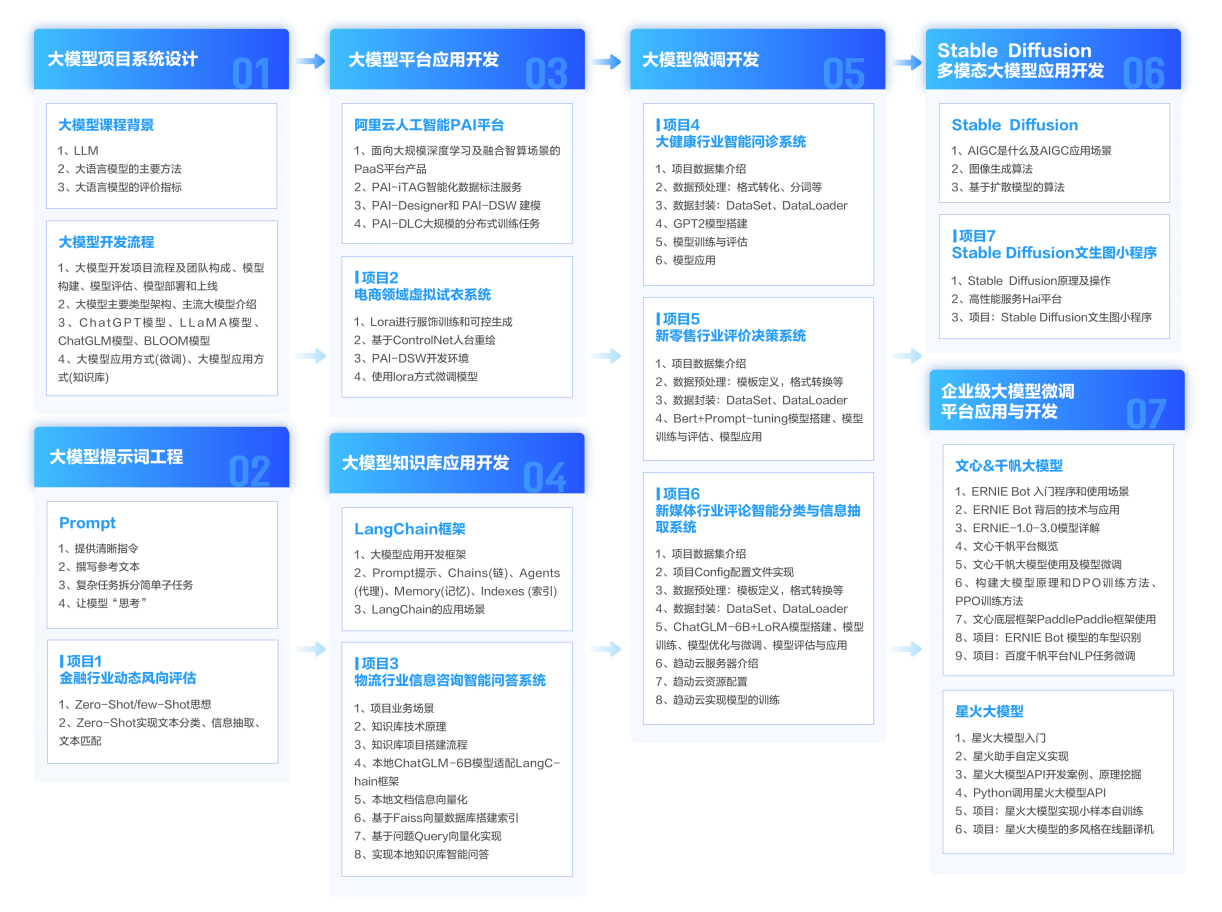

二、AI大模型实战案例
涵盖AI大模型的理论研究、技术实现、行业应用等多个方面。无论您是科研人员、工程师,还是对AI大模型感兴趣的爱好者,皆可用。



三、视频和书籍PDF合集
从入门到进阶这里都有,跟着老师学习事半功倍。



四、LLM面试题


五、AI产品经理面试题

六、deepseek部署包+技巧大全

😝朋友们如果有需要的话,可以V扫描下方二维码联系领取~
























 907
907

 被折叠的 条评论
为什么被折叠?
被折叠的 条评论
为什么被折叠?








